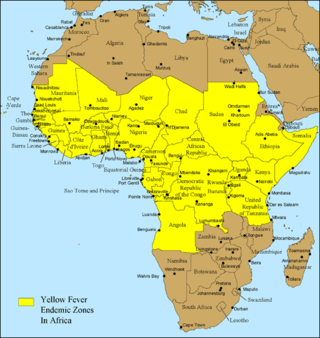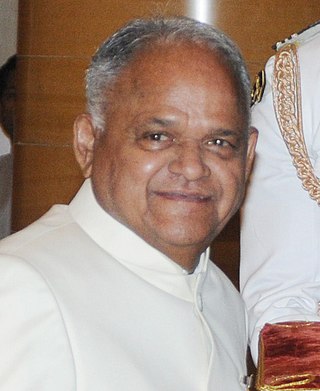
Malaria is a mosquito-borne infectious disease that affects humans and other animals. Malaria causes symptoms that typically include fever, tiredness, vomiting, and headaches. In severe cases, it can cause jaundice, seizures, coma, or death. Symptoms usually begin ten to fifteen days after being bitten by an infected mosquito. If not properly treated, people may have recurrences of the disease months later. In those who have recently survived an infection, reinfection usually causes milder symptoms. This partial resistance disappears over months to years if the person has no continuing exposure to malaria.

Anopheles is a genus of mosquito first described and named by J. W. Meigen in 1818. About 460 species are recognised; while over 100 can transmit human malaria, only 30–40 commonly transmit parasites of the genus Plasmodium, which cause malaria in humans in endemic areas. Anopheles gambiae is one of the best known, because of its predominant role in the transmission of the most dangerous malaria parasite species – Plasmodium falciparum.
Tropical diseases are diseases that are prevalent in or unique to tropical and subtropical regions. The diseases are less prevalent in temperate climates, due in part to the occurrence of a cold season, which controls the insect population by forcing hibernation. However, many were present in northern Europe and northern America in the 17th and 18th centuries before modern understanding of disease causation. The initial impetus for tropical medicine was to protect the health of colonial settlers, notably in India under the British Raj. Insects such as mosquitoes and flies are by far the most common disease carrier, or vector. These insects may carry a parasite, bacterium or virus that is infectious to humans and animals. Most often disease is transmitted by an insect bite, which causes transmission of the infectious agent through subcutaneous blood exchange. Vaccines are not available for most of the diseases listed here, and many do not have cures.
The International Centre of Insect Physiology and Ecology is an international scientific research institute, headquartered in Nairobi, Kenya that works towards improving lives and livelihoods of people in Africa.

The Indian Council of Medical Research (ICMR), the apex body in India for the formulation, coordination and promotion of biomedical research, is one of the oldest and largest medical research bodies in the world.
Paratransgenesis is a technique that attempts to eliminate a pathogen from vector populations through transgenesis of a symbiont of the vector. The goal of this technique is to control vector-borne diseases. The first step is to identify proteins that prevent the vector species from transmitting the pathogen. The genes coding for these proteins are then introduced into the symbiont, so that they can be expressed in the vector. The final step in the strategy is to introduce these transgenic symbionts into vector populations in the wild. One use of this technique is to prevent mortality for humans from insect-borne diseases. Preventive methods and current controls against vector-borne diseases depend on insecticides, even though some mosquito breeds may be resistant to them. There are other ways to fully eliminate them. “Paratransgenesis focuses on utilizing genetically modified insect symbionts to express molecules within the vector that are deleterious to pathogens they transmit.” The acidic bacteria Asaia symbionts are beneficial in the normal development of mosquito larvae; however, it is unknown what Asais symbionts do to adult mosquitoes.

The African Malaria Network Trust (AMANET) is a pan-African international NGO headquartered in Dar es Salaam, Tanzania. It originally started its activities as African Malaria Vaccine Testing Network (AMVTN) in 1995 with the primary goal of preparing Africa in planning and conducting malaria vaccine trials. In order to widen the scope in malaria interventions, AMVTN was succeeded by AMANET on 14 March 2002. Although the primary goal of AMANET has remained malaria vaccine development, the organization in its expanded role includes other intervention measures such as antimalaria drugs and vector control.

Mosquito-borne diseases or mosquito-borne illnesses are diseases caused by bacteria, viruses or parasites transmitted by mosquitoes. Nearly 700 million people get a mosquito-borne illness each year resulting in over 725,000 deaths.

Sir Gordon Covell was a physician and a major general in the army of British India, and a leading global expert on Malaria disease control and eradication efforts in the middle of the 20th century. He was member of the expert committee on malaria set up by the WHO from 1948 to 1958, of which he served as the secretary. At that time, he was also an advisor to the British Ministry of Health and the Director of the Malaria Laboratory at Horton Hospital.

The National Centre for Disease Control is an institute under the Indian Directorate General of Health Services, Ministry of Health and Family Welfare. It was established in July 1963 for research in epidemiology and control of communicable diseases and to reorganize the activities of the Malaria Institute of India. It has nine branches at Alwar, Bengaluru, Trivandrum, Calicut, Coonoor, Jagdalpur, Patna, Rajahmundry and Varanasi to advise the respective state governments on public health. The headquarters are in Sham Nath Marg, in New Delhi.
Rajpal Singh Yadav is an Indian scientist in the field of vector ecology and management at World Health Organization headquarters, Geneva, Switzerland. He has been working with various countries and international organizations to formulate and promote policies for public health pesticide management and vector control.

Vinod Prakash Sharma was an Indian malariologist and entomologist, known for his work in vector biology and bioenvironmental control of malaria. Recipient of many awards, including the Padma Shri, he was again honoured by the Government of India, in 2014, by bestowing on him the third highest civilian award, the Padma Bhushan.
Pylore Krishnaier Rajagopalan is an Indian vector control scientist, biologist and acarologist, known for his pioneering contributions to the control programmes against vector-borne diseases in India. He is a former director of the Indian Council of Medical Research managed Vector Control Research Centre, Pondicherry. He graduated in 1949 from the Banaras Hindu University and obtained a Masters in Zoology with University First Rank there itself in 1951. In 1952 he joined the fledgling Virus Research Centre in Pune, and worked under the supervision of some of the finest vector control specialists such as Dr T Ramachandra Rao. In recognition of his outstanding work as a young research scientist, in 1957 he was awarded a Fellowship by the Rockefeller Foundation to pursue a Master's program in Public Health from the University of California. He went on to secure a Diploma in Acarology from the University of Maryland at College Park.
The Innovative Vector Control Consortium (IVCC) is a not-for-profit, product development partnership (PDP) designed to facilitate the development and delivery of new and improved vector control tools to prevent malaria and other neglected tropical diseases. Their mission is to save lives, protect health and increase prosperity in areas where disease transmitted by insects is endemic.
The Malaria Eradication Scientific Alliance (MESA) is an organization founded on the research carried out by the Malaria Eradication Research Agenda (malERA). "malERA" was a project carried out by the scientific community to identify the steps and future research that must be done in order to eradicate malaria. It was created after the Malaria Forum in 2007, hosted by the Bill and Melinda Gates Foundation, reestablished malaria eradication as a long-term goal. "malERA" first launched in 2008, and resulted in a research and development agenda which was published in a PLoS Medicine magazine in 2011. MESA was formed in 2012 to continue the goals of malERA through research and development of methods to fight malaria.
Yagya Dutta Sharma is an Indian molecular biologist, professor and head of the department of biotechnology at the All India Institute of Medical Sciences, Delhi. An elected fellow of all three major Indian science academies — Indian National Science Academy, Indian Academy of Sciences, and National Academy of Sciences, India — Sharma is known for his research on the molecular biology of malaria. The Council of Scientific and Industrial Research, the apex agency of the Government of India for scientific research, awarded him the Shanti Swarup Bhatnagar Prize for Science and Technology for his contributions to medical sciences in 1994.
Deepak Gaur was an Indian molecular biologist, and a professor at the School of Biotechnology of Jawaharlal Nehru University. Known for his studies on Plasmodium falciparum, Gaur is a recipient of the N-Bios Prize. The Council of Scientific and Industrial Research, the apex agency of the Government of India for scientific research, awarded him the Shanti Swarup Bhatnagar Prize for Science and Technology, one of the highest Indian science awards, for his contributions to medical sciences in 2017.

Anopheles atroparvus is a European species of mosquito, which was first identified in 1927. It is one of the most abundant palearctic Anopheles species belonging to the family Culicidae, commonly called mosquitoes. Although research interest in A. atroparvus has been low in the past several decades, recent concern for an increase in vector-borne disease has encouraged new research into this species.
Aditya Prasad Dash, who hails from the Indian State of Odisha, is an Indian biologist with special interest in malaria and vector borne diseases. His areas of interest include biomedical science, transmission biology of tropical disease, and modern biology of disease vectors. According to Vidwan, the national network for researchers and experts, Dash has authored 320 publications co-authored 699 publications. Since September 2020, Dash has been serving as the Vice Chancellor of Asian Institute of Public Health (AIPH) in Bhubaneswar. Before joining AIPH, he was the Vice Chancellor of Central University of Tamil Nadu during the period from August 2015 to August 2020. He had also worked at the World Health Organization (WHO) as the Regional Advisor for the South-East Region. He has also worked as the Director of the National Institute of Malaria Research (NIMR), New Delhi, of the Institute of Life Sciences (ILS), Bhubaneswar and of the National Institute for Research on Tribal Health, Jabalpur.
Marcelo Jacobs-Lorena is a Brazilian-American molecular entomologist. He is a professor in the department of molecular microbiology and immunology at Johns Hopkins Bloomberg School of Public Health. In 2002, his team loaded mosquitoes with a modified gene so that their guts produce a substance that kills off Plasmodium.










